mybatis与数据库访问相关的配置以及设计
mybatis与数据库访问相关的配置以及设计
mybatis不管如何NB,总是要与数据库进行打交道。通过提问的方式,逐步深入
- 我们常用的MyBatis配置中哪些是与数据库相关?
- 数据源配置:
<environment id="development">
<transactionManager type="JDBC"/>
<dataSource type="POOLED">
<property name="driver" value="${driver}"/>
<property name="url" value="${url}"/>
<property name="username" value="${username}"/>
<property name="password" value="${password}"/>
</dataSource>
</environment>
看到这个配置文件,第一个直觉会想到由谁读取配置文件,谁有读取了配置信息?先忽略这个疑问,跳过。直接看下面的问题
1.配置数据源信息后,由谁来创建、管理数据源?
根据JDBC驱动中约束的接口,Connection需要DataSource中获取
如果自己设计,是否直接可以由工厂返回Connection?有什么好处,有什么坏处? //TODO
没看代码前:
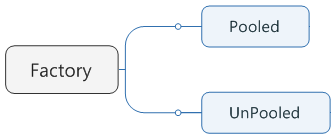
实际Mybatis设计,没有直接返回Connection,而返回了dataSource
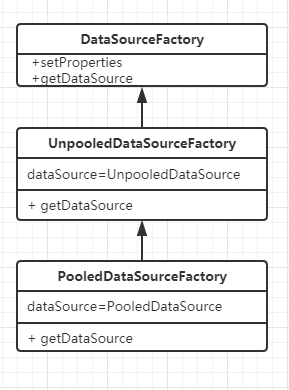
2.对于有连接池的数据源,和无连接池的数据源,我们自己会如何设计?
流程上的区别
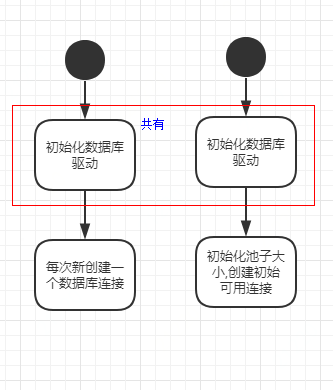
职责上区别
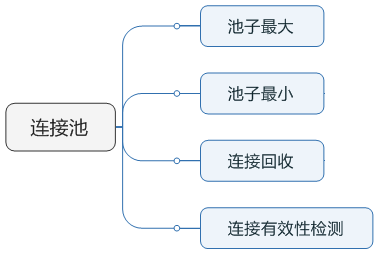
现在解开谜底:看实际Mybatis设计如何?
非池化类:
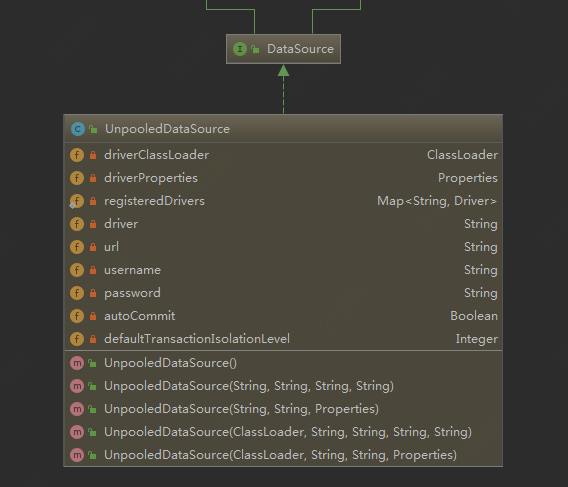
看下最关键的,获得数据库连接,和我们自己写的没啥区别。简单粗暴
private Connection doGetConnection(Properties properties) throws SQLException {
initializeDriver();
Connection connection = DriverManager.getConnection(url, properties);
configureConnection(connection);
return connection;
}
池化类:
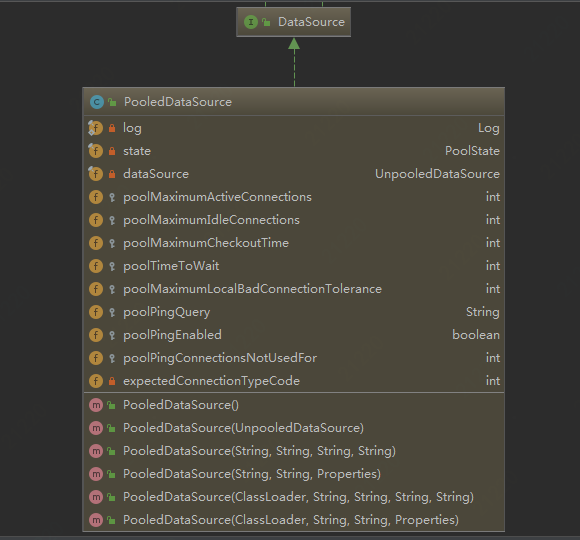
池化工作分配 :
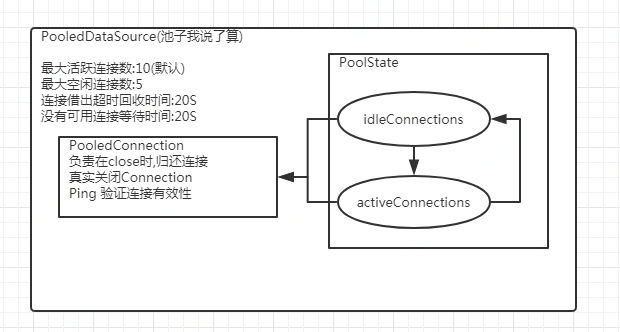
至此,MYBABTIS对于数据源的创建以及管理结束!看下代码,池化获得连接的代码
@Override
public Connection getConnection() throws SQLException {
return popConnection(dataSource.getUsername(), dataSource.getPassword()).getProxyConnection();
}
while (conn == null) { //够用就行,拿到一个就返回
synchronized (state) {
//只有有连接还回来,再走这里
if (!state.idleConnections.isEmpty()) {
// Pool has available connection
conn = state.idleConnections.remove(0);
if (log.isDebugEnabled()) {
log.debug("Checked out connection " + conn.getRealHashCode() + " from pool.");
}
} else {
//有两种可能:1种,都在使用中,池子没满,再新建
// Pool does not have available connection
if (state.activeConnections.size() < poolMaximumActiveConnections) {
// Can create new connection
//新建连接
conn = new PooledConnection(dataSource.getConnection(), this);
if (log.isDebugEnabled()) {
log.debug("Created connection " + conn.getRealHashCode() + ".");
}
} else {
// Cannot create new connection
//找一个最老的,用的ArrayList,老的在ArrayList数组的前面
PooledConnection oldestActiveConnection = state.activeConnections.get(0);
long longestCheckoutTime = oldestActiveConnection.getCheckoutTime();
//借出超时,不让他做了,直接rollback。。。暴力
if (longestCheckoutTime > poolMaximumCheckoutTime) {
// Can claim overdue connection
state.claimedOverdueConnectionCount++;
state.accumulatedCheckoutTimeOfOverdueConnections += longestCheckoutTime;
state.accumulatedCheckoutTime += longestCheckoutTime;
state.activeConnections.remove(oldestActiveConnection);
if (!oldestActiveConnection.getRealConnection().getAutoCommit()) {
try {
oldestActiveConnection.getRealConnection().rollback();
} catch (SQLException e) {
/*
Just log a message for debug and continue to execute the following
statement like nothing happend.
Wrap the bad connection with a new PooledConnection, this will help
to not intterupt current executing thread and give current thread a
chance to join the next competion for another valid/good database
connection. At the end of this loop, bad {@link @conn} will be set as null.
*/
log.debug("Bad connection. Could not roll back");
}
}
//拿回来后,不再放到原有的PooledConnection,新建立一个。从新开始.老的REAL connection还被oldestActiveConnection引用,不会内存溢出?
conn = new PooledConnection(oldestActiveConnection.getRealConnection(), this);
conn.setCreatedTimestamp(oldestActiveConnection.getCreatedTimestamp());
conn.setLastUsedTimestamp(oldestActiveConnection.getLastUsedTimestamp());
oldestActiveConnection.invalidate();
if (log.isDebugEnabled()) {
log.debug("Claimed overdue connection " + conn.getRealHashCode() + ".");
}
} else {
// Must wait
//大家都在用着,你只能等着了。
try {
if (!countedWait) {
state.hadToWaitCount++;
countedWait = true;
}
if (log.isDebugEnabled()) {
log.debug("Waiting as long as " + poolTimeToWait + " milliseconds for connection.");
}
long wt = System.currentTimeMillis();
state.wait(poolTimeToWait);
state.accumulatedWaitTime += System.currentTimeMillis() - wt;
} catch (InterruptedException e) {
break;
}
}
}
}
if (conn != null) {
// ping to server and check the connection is valid or not
if (conn.isValid()) {
if (!conn.getRealConnection().getAutoCommit()) {
conn.getRealConnection().rollback();
}
conn.setConnectionTypeCode(assembleConnectionTypeCode(dataSource.getUrl(), username, password));
conn.setCheckoutTimestamp(System.currentTimeMillis());
conn.setLastUsedTimestamp(System.currentTimeMillis());
state.activeConnections.add(conn);
state.requestCount++;
state.accumulatedRequestTime += System.currentTimeMillis() - t;
} else {
if (log.isDebugEnabled()) {
log.debug("A bad connection (" + conn.getRealHashCode() + ") was returned from the pool, getting another connection.");
}
state.badConnectionCount++;
localBadConnectionCount++;
conn = null;
//如果累计有这些个链接失效了,则报个异常.
if (localBadConnectionCount > (poolMaximumIdleConnections + poolMaximumLocalBadConnectionTolerance)) {
if (log.isDebugEnabled()) {
log.debug("PooledDataSource: Could not get a good connection to the database.");
}
throw new SQLException("PooledDataSource: Could not get a good connection to the database.");
}
}
}
}
}
mybatis与数据库访问相关的配置以及设计的更多相关文章
- SpringBoot:4.SpringBoot整合Mybatis实现数据库访问
在公司项目开发中,使用Mybatis居多.在 SpringBoot:3.SpringBoot使用Spring-data-jpa实现数据库访问 中,这种jpa风格的把sql语句和java代码放到一起,总 ...
- mysql+spring+mybatis实现数据库读写分离[代码配置] .
场景:一个读数据源一个读写数据源. 原理:借助spring的[org.springframework.jdbc.datasource.lookup.AbstractRoutingDataSource] ...
- Spring Mvc和Mybatis的多数据库访问配置过程
Spring Mvc 加Mybatis的多数据库访问源配置访问过程如下: 在applicationContext.xml进行配置 <?xml version="1.0" en ...
- Spring+MyBatis实践—MyBatis数据库访问
关于spring整合mybatis的工程配置,已经在Spring+MyBatis实践—工程配置中全部详细列出.在此,记录一下几种通过MyBatis访问数据库的方式. 通过sqlSessionTempl ...
- 使用MyBatis搭建一个访问mysql数据库的简单示例
MyBatis是一个支持普通SQL查询,存储过程和高级映射的优秀持久层框架.MyBatis消除了几乎所有的JDBC代码和参数的手工设置以及对结果集的检索封装.MyBatis可以使用简单的XML或注解用 ...
- Spring+MyBatis双数据库配置
Spring+MyBatis双数据库配置 近期项目中遇到要调用其它数据库的情况.本来仅仅使用一个MySQL数据库.但随着项目内容越来越多,逻辑越来越复杂. 原来一个数据库已经不够用了,须要分库分表.所 ...
- Spring+Mybatis+Mysql搭建分布式数据库访问框架
一.前言 用Java开发企业应用软件, 经常会采用Spring+MyBatis+Mysql搭建数据库框架.如果数据量很大,一个MYSQL库存储数据访问效率很低,往往会采用分库存储管理的方式.本文讲述如 ...
- spring配置druid连接池和监控数据库访问性能
Druid连接池及监控在spring配置如下: <bean id="dataSource" class="com.alibaba.druid.pool.DruidD ...
- SpringBoot入门 (四) 数据库访问之JdbcTemplate
本文记录在SpringBoot中使用JdbcTemplate访问数据库. 一 JDBC回顾 最早是在上学时接触的使用JDBC访问数据库,主要有以下几个步骤: 1 加载驱动 Class.forName( ...
随机推荐
- [转]CentOS7利用systemctl添加自定义系统服务
原文:https://www.cnblogs.com/saneri/p/7778756.html CentOS7自定义系统服务 CentOS7的服务systemctl脚本存放在:/usr/lib/sy ...
- QWaiteCondition思考4
引用 http://blog.csdn.net/flyoxs/article/details/54617342 简单用法 QWaitCondition 用于多线程的同步,一个线程调用QWaitCond ...
- EfRepository
using System;using System.Collections.Generic;using System.Linq;using System.Linq.Expressions;using ...
- 数字特征值-python
#Digital eigenvalue.py number = eval(input()) count = 0 Ob = 0 Ox = 0 while number > 0: Ob = numb ...
- Android版本28使用http请求
Android版本28使用http请求报错not permitted by network security policy android模拟器调试登录的时候报错 CLEARTEXT communic ...
- 输入框VS软键盘
最近在做一个h5的时候遇到的问题 我们都知道当页面上的有输入框被选中了,这个时候就回调出键盘用户可以输入.但是安卓手机在弹出键盘时页面的输入框也会被覆盖住: 以下为暂时的解决办法:(以下方法同时解决了 ...
- backref 用法
源码 def backref(name, **kwargs): """Create a back reference with explicit keyword argu ...
- Appium环境搭建——安卓模拟器(AVD)调试 2-运行Apk失败点的总结
如何优化AVD模拟器运行速度? 解决方法:开启IntelHAXM 查询intelhaxm是否已经开启: sc query intelhaxm 若开启成功,则如图所示 若没有开启,可以通过BIOS打开, ...
- Web前端3.0时代,“程序猿”如何“渡劫升仙”
Web前端入行门槛低,很多人在成为前端工程师后很容易进入工作的舒适区,认为该熟悉的业务已熟悉了,然后就是重复用轮子,这样很容易让自己的成长处于原地打转以及低水平重复的状态. 想要不被行业抛弃,就要努力 ...
- Yii2 使用 QQ 和 Weibo 第三方登录源码
我们社区在 yii2-authclient 多次升级后,登录异常.一直想寻求一种通用的方法,尽量不重写 OAuth2, BaseOAuth 以及 OAuthToken 类, 所以本次直接在 initU ...
